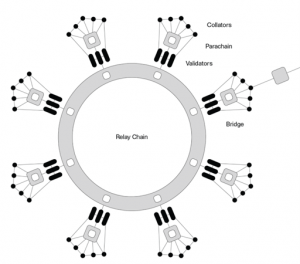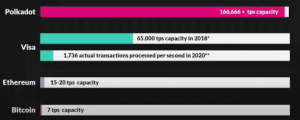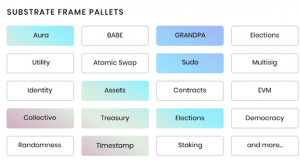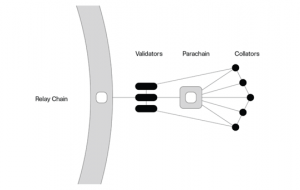Polkadot seeks to create a decentralized internet where users retain control of their own privacy. This goal, along with making it far more cost-effective for blockchain technology to be created in a single network, is what makes Polkadot one of the most intriguing blockchain projects.
Polkadot Market Cap
Think back to the dawn of the internet in the early 2000s. The interfaces were minimal, with not much to click on, containing only basic features. This ‘read-only’ web is Web 1.0.
Compare this to the interactive, lively web pages we have now. You can click on videos, play games, publish information in seconds, interact through social media, make video calls, access bank accounts, and web pages have smooth user interfaces. This advancement that we’re currently living in is Web 2.0.
Our lives are now interwoven with Web 2.0. From work to play to social interaction, Web 2.0 has become fundamental to the existence of the modern human being.
The major problem with this is that privacy and data have to be given up in order to participate in society. This issue is at the heart of Polkadot’s overarching vision to create a Web 3.0.
The Founding of Polkadot
Dr. Gavin Wood, a co-founder and CTO of Ethereum, mused that Ethereum would only be a ‘small piece of the puzzle’. While developing Parity Ethereum, an open-source software on mining Ether, he came up with an idea for the Polkadot Protocol, a heterogeneous multi-chain framework.
In 2017, Parity’s Peter Szaban and Gavin Wood co-founded the non-profit Web3 Foundation. Its function was to foster the research and development of decentralized web protocols. Much of this research was to aid in Polkadot’s research foundations. The Web3 Foundation also managed funds for the Polkadot token sale, which would soon become $43 million worth of Bitcoin raised.
Many of Polkadot’s ambitions can be linked to this partnership. Wood coined the phrase ‘Web 3.0’ with a vision to make a fully decentralized web, where the people’s data and identity are self-owned, shielded from a central authority.
Private data concerns from giants like Facebook and Google has people fighting for privacy in the modern age. In a sense, Polkadot is joining this fight, wanting to create a decentralized internet for humanity.
What is Polkadot?
Polkadot aims to be a network protocol that allows data to be transferred across blockchains. It’s the unity of a network of heterogeneous blockchains, which polkadot calls parachains.
Imagine this. Let’s say that each individual blockchain was like every country having their own internet. Imagine if there was a UK internet, a Chile internet, a US internet, a Japan internet, etc. and they had a difficult time communicating with one another. Imagine that you would have to make a phone call in order to relay something from the UK internet to the Japan internet, rather than being able to see something pop up from the UK instantaneously.
You can make those phone calls, but it would take more time and resources. You also won’t know whether there was something in the communication that has been lost. This is how the older blockchains function, more as independent silos than a true network. Polkadot aims to solve this problem, to unite the heterogeneous blockchains, or parachains, into a network.

The Polkadot relay chain is what ties the networks together. This allows for interoperability and scalability for anything built on top of its blockchain, attempting to solve some fundamental problems of blockchain today. Blockchains usually operate independently of one another, making an interoperable network extremely valuable in transferring information, like having one worldwide web rather than each country having their own internet.
Blockchains are also difficult to scale because of slow network speed. Polkadot provides a solution by creating a network of separate blockchains, or a sharded blockchain, allowing them to exchange data and process parallel transactions.
Usability is also a massive selling point of Polkadot, featuring what they call ‘substrates.’ They hope to provide a great amount of freedom to anything built on the blockchain while also having a base foundation to work with.
Imagine that someone had to create a whole website from the ground up, with security, treasury, accounts and balances, data storage, etc. Now, imagine that all of that was already given to you and all you had to do was structure your game, business, art platform, etc. around these. You can choose which aspects you wish to keep and wish to take away. You can also code in whatever you need.
And your project would be interoperable with anything in a whole network.
At a Polkadot Summit in 2020, Gavin Wood builds a decentralized app in the span of an hour and a half, showing just how many resources and time can be saved. This is at the crux of Polkadot’s vision of a cost-efficient Web 3.0.
Blockchain Problems Polkadot Wants to Solve
Bitcoin and Ethereum helped lay the foundation for much of the blockchain technology produced today. But what are the problems of older blockchain technology that Polkadot aims to remedy?
1. They have a hard time communicating with one another.
Blockchains are good at transferring data within their network but have a hard time understanding other networks without an intermediary.
2. They can’t scale because they can’t handle a lot of traffic.
Bitcoin only allows for 7 transactions per second (tps) while Ethereum allows for 15-20tps. Visa, for example, can process a maximum of 65,000tps.
3. Poor security makes them vulnerable to hackers.
Although Bitcoin and Ethereum are extremely secure, security was a common problem among many upcoming blockchains. It’s incredibly difficult to create secure blockchains, which is why a plethora of news headlines have, in the past, been filled with blockchains being hacked.
4. Lack of customization
There isn’t a vast array of customization in blockchain. If you want to choose existing legacy blockchains like Bitcoin or Ethereum, you are subject to their parameters. You might not have features you want, like those made precisely for NFTs, music, business, etc.
If you don’t choose that option, you have to create your own blockchain, with the monumental task of creating it from scratch, which costs a vast amount of time and resources.
5. Poor governance
Legacy networks usually have one individual or one group that make the decisions.
To map out the future of a blockchain, existing blockchains are usually governed by an entity that is too centralized, subject to a ‘benevolent dictator,’ or development team that makes the decisions for that blockchain, decisions like whether the supply should be more or less than the current supply.
It’s either that or community-based governance that isn’t fleshed out well.
There are whole tokens that function solely for governance as it’s a complex issue in the blockchain space.
6. Upgrades are problematic
The network could split into two if the users do not upgrade them independently. This is a huge issue. Every single user’s software needs to be upgraded, or else a ‘fork’ occurs. In a ‘fork’ scenario, upgraders think one version is the correct one while other upgraders think the non-upgraded version is the correct one. The upgraded and non-upgraded users will view totally different blocks.
The most famous example of this is the Ethereum ‘hard-fork’, where an exploit led to the Ethereum community having to generate two separate blockchains, the original one called Ethereum classic and the new one keeping the name Ethereum. All funds were subsequently restored.
Imagine the immense task needed to have all users comply to a new software upgrade. If not, and they become separated, the softwares are permanently severed. There is no way for the two to have interchangeable data. You would need the community to completely ignore the older software, leaving behind those who didn’t upgrade.
What are Polkadot’s Solutions to these Problems?
First, we’ll examine the solutions to each of these problems and how Polkadot is planning to solve them.
- Create an interconnected network
- Being able to handle traffic to a point of scalability
- Impeccable security
- Excellent customization platforms for apps
- Multi-faceted governance mechanism with more democratic decision-making
- Easily upgradable for the future
Let’s tackle each one of these points.
1. Create an interconnected network
So how would Polkadot create an interconnected network? If we look at a legacy Blockchain like Bitcoin, it’s built to do a certain thing really well, a form of cryptographic, decentralized digital currency. If we look at a legacy blockchain like Ethereum, we’ll see that it’s built to do many things decently by creating fungible and non-fungible tokens, games, decentralized finance, etc. These various functionalities operate independently of one another instead of working together on a network.
If Polkadot’s ambitions were to be fully realized, new networks that wouldn’t otherwise be connected on other platforms will be connected to Polkadot. Not only that, there will be ‘bridges’ that will allow Polkadot to connect to legacy blockchains, like Bitcoin or Ethereum, as well as to Kusama, Polkadot’s sister network.
2. Scalability
It’s commonly known that Bitcoin and Ethereum have extremely slow transaction speeds compared to traditional transactions like those in Visa or Mastercard. Though they’re secure and sophisticated blockchains with high security, check this diagram to see just how slow.

Bitcoin’s transactions per second amounts to only 7 transactions per second (tps). Ethereum’s tps is way better, allowing for 15-20 tps. These still pale in comparison to Visa, with an actual 1736 tps (on a day-to-day basis), able to process 65.000 tps if pushed to the limit. Its max tps is 9.285 times faster than Bitcoin and actually processed tps 248 times faster than Bitcoin. Visa is also 3.250 times faster at max tps than Ethereum’s 20tps and is 87 times faster at day-to-day processed tps.
And the projection for Polkadot’s transaction speed is around 166.666 tps! That is 2,5 times faster than Visa’s max and 96 times faster than Visa’s practical daily use application. It’s also 23.809 times faster than Bitcoin and 8.333 times faster than Ethereum.
However, Gavin Wood has proclaimed that it’s possible for Polkadot’s transaction speed to be 1 million tps! Ethereum 2.0, the successor to Ethereum, is projected to have 100.000 tps. So if these projections stay consistent through its stages of development, Polkadot’s transactions per second will be top tier and highly competitive, if not the absolute fastest, in the ecosystem.
How is this possible? Traditional blockchains use single transaction methods, one-by-one, on network nodes. Polkadot, on the other hand, processes through parallel transactions, which allows, in Polkadot’s terms, ‘infinite scalability.’
Polkadot’s scalability will be hard to match if their projections are realized.
3. Security
Security is a costly endeavor for many projects on blockchain. Polkadot aims to have a base level of security implemented to any parachains in their interconnected ecosystem. This would save a vast amount of time and money if pulled off, since security expertise on blockchain isn’t the easiest resource to find.
What will this security look like?
Polkadot wants to implement what they call ‘pooled security’. Validators verify information in parachain blocks and function in consensus mechanisms. Anything in the Polkadot Relay Chain will benefit from the security found in the validators. Usually what’s found in other architectures are bridge protocols, not a ‘pooled security’. In a bridge protocol, validators are on an island with their own validator set and economic security. This can be exploited with a ‘51% attack’, if bigger coins have more leverage in security in a network, as the lower altcoins would have less economic security.
To solve this issue, all the economic incentives will be attached to the relay chain.

Say each parachain is a blockchain project where an altcoin, game, or other application can be built on. If they were just independent silos, then their security would need heavy resources to be built from the ground up. But if they were a part of Polkadot’s Relay Chain, the security resources will be taken care of. And not only will the security resources be more economically feasible, each project will be part of an interconnected shared, ‘pooled security’ network that will benefit from Polkadot’s overall security.
Any new project on the parachain will benefit from Polkadot’s security system.
4. Excellent customization platforms for apps
In solving customization, Polkadot wants there to be enough choice that there are varying degrees to the features being implemented in what Polkadot calls substrates. You can visualize these like options that you can pick and choose, and each of them have varying degrees of utility.
So what are substrates? The idea is similar to web application frameworks. Instead, these would be decentralized systems. If achieved on a wide scale, it would be like how most web applications today don’t need to build consensus code like HTTP from the ground up and hiring specialized experts to build consensus, networking, file storage, project release, etc. for each project. You can only imagine the amount of time and resources this would save developers everywhere.
It’s made clearer when you look at the Substrate FRAME pallets.

For example, if someone wanted to create a blockchain with elections, assets, timestamps, treasury, and more, they would choose these from the given FRAME pallets. FRAME stands for Framework for Runtime Aggregation of Modularized Entities. The modules, each rectangle shown above, are what are called ‘pallets’ and simplify the ‘runtime’ or the execution environment. In simpler terms, they’re the individual components needed to create a customized blockchain using Polkadot substrates, without having to start from scratch.
These customizations will be drag and drop, making it easier to create whatever application you want, with varying gradations of usability for each module. You can only imagine what this network will become if all its ambitions were fully realized. Since less specialized experts will be needed for certain features, it would save so much time and money for developers everywhere. This is a large reason why Polkadot’s vision has become widely supported and why it’s currently one of the leading altcoins today.
5. Multi-faceted governance mechanism with democratic decision-making
What is governance in blockchain? Governance, also known as on-chain governance, is responsible for supervising and carrying out changes to cryptocurrency blockchains. Governance in the legacy cryptocurrencies like Bitcoin and Ethereum are done by developers. These developers manage and attain consensus between stakeholders. Stakeholders have traditionally been users, miners, and developers.
In contrast, Polkadot has a far more thought-out governance mechanism than blockchain projects. The entire Polkadot community would submit and vote on decisions that influence the network’s future trajectory. Any holder of DOT is part of what resembles a modern democratic system in that you can become a council member, vote for council members, propose a public referendum, give priority to certain public referenda, and vote on all active referenda.
Changes in Polkadot referenda are enacted by a stake-weighted majority. There are mechanisms in place that take into account problems in traditional governance systems. For example, decentralized public networks that have tried voting methods suffer from low voter turnout, unless it is heavily politicized. Polkadot attempts to solve these problems through Adaptive Quorum biasing. This method adapts to the supermajority needed for referenda to pass depending on voter turnout percentage.
6. Easily Upgradable for the Future
We’ve already discussed how legacy networks don’t easily upgrade and a ‘fork’ can occur where two separate blockchains form. If Polkadot’s vision becomes fully realized, it is fully future-proof and can upgrade without splitting the chain or community. When an upgrade takes place, the whole network is in agreement. Going from the pre-upgraded version to the post-upgraded version will not have the headaches that usually plagued legacy blockchains before.
This ease would be comparable to how upgrades in modern PCs can be upgraded by connecting to the internet and downloading the necessary software. Whereas legacy blockchains would be more like using a CD to upgrade each computer, and those who didn’t upgrade would have distinct functionality and data than the ones that did, ultimately being left behind on a separate network.
A closer, technical look into the Polkadot Relay Chain, Parachains, Parathreads, and Bridges

The Relay Chain is the Polkadot’s central chain, the one that connects the entire system through validators. The Relay Chain doesn’t actually do a whole lot. Its whole purpose is creating and managing a network of parachains and parathreads. The parachains and parathreads are responsible for the micro functionalities of Polkadot. Parachains are the processes that are always running, while parathreads are delegated tasks that are shared and not routinely used. Parathreads can become parachains and parachains can become parathreads, adding a level of flexibility to the system.
A fundamental thing to note about parachains are nodes called collators. They produce and propose blocks to implement for their parachains, like collecting transactions from users. But a specific parachain’s logic is what makes the decisions for what collators propose to the parachain.
Proofs from the collators are validated through the validators, securing themselves onto the overarching Relay Chain through stakes of DOT. By adding new blocks to the Relay Chain, parachains can complete transactions across other parachains through the Relay Chain. Validators also punish ‘bad actors’ in the system by removing DOT, if the consensus algorithms do not seem to adhere to the overall logic.
But how does the network communicate with other ones that are, otherwise, technologically distinct and economically separate? This interoperability will be using a foundational technology in blockchain called bridges. They can be centralized or decentralized. Although fundamentally agnostic, decentralized bridges will be favored over centralized ones. These bridges will be what allows legacy networks like Bitcoin and Ethereum, as well as other separate and sovereign blockchains, to operate within the Polkadot ecosystem.
In light of this, Polkadot should not be seen as being a competitor to platforms like Ethereum. Ethereum is a single mechanism in which developers write smart contracts on. Polkadot’s mechanics operate on singular blockchains. Polkadot will support smart contract blockchains although the Relay Chain itself will not have smart contract functionality. Rather than a fierce competitor to Ethereum, Polkadot should be seen as a boon for Ethereum’s possible scalability.’
Roadmap and Future
With Polkadot’s market cap rising higher in the 2021 bull run, its future is promising. The road it took to get to this point was years in the making. The roadmap it took was as follows:
1. Proof of Authority
Under the PoA phase, users used Ethereum contracts to claim tokens, staked tokens as a validator or nominator, set Session keys in anticipation for Proof of Stake, had the Sudo key govern and enable features, and held the first validator elections held after a smooth-running network.
2. Nominated Proof of Stake
With NPoS, a decentralized set of validators ran the network with Sudo expanding the amount of validators in the same group. Polkadot’s governance system was run with the Sudo key after the network was operational.
3. Governance and Removing Sudo
Polkadot began to accept public proposals and had the Sudo system slowly removed as governance took over. Token holders will then decide Polkadot’s fate without Sudo.
4. Enable balance transfers
After balance transfers are enabled, Polkadot will undergo runtime upgrades to make way for the phase at the current writing of this text.
5. Parachain rollout – current phase
Parachains are currently being tested and audited. After optimization on parachains and Kusama, slot lease auctions will ensue. After this phase completes, the governance community will decide Polkadot’s future evolution as the network will have completed.
6. Future Upgrades
Future upgrades are decided by the governance community after they’re developed, tested, benchmarked, and audited. Some of these future upgrades include Cross-Chain Message Passing and parathreads.
Overall Vision
The developers at Polkadot want to realise a blockchain network that is as accessible and recognizable as the non-blockchain apps currently in existence. Right now, apps like Skype, YouTube, Instagram, Amazon, etc. are well-integrated in the internet ecosystem, functioning as part of a seamless network.
Similar to these databases, everyday users shouldn’t even notice that they are on a blockchain, like how users of current internet applications don’t notice that their application was created with SQL.
From enterprise (data storage, healthcare, finance, etc.), to government (smart contract law, identity management, university education, etc.), to consumer use (social network, gaming, personal finance, etc.), Polkadot aims to create a speedy, interconnected, smooth-functioning network that allows high customization and good foundation to any new projects that are added as parachains to their network.
When Gavin Wood demonstrated in a conference that a simple decentralized application can be made using Polkadot in less than two hours, the vision has never looked more achievable. We look forward to seeing Polkadot’s progress in creating a decentralized ‘Web 3.0’.
Token information
The ICO for Polkadot closed on October 17, 2017 and raised USD 144,630,000. As of March 2021, there are 852,647,705 circulating DOT in supply with a max supply of 1,058,764,904 DOT. The original ICO amount was a max supply of 10,000,000, but this was increased to encourage usage of the network. DOT tokens, by design, have a 10% inflation rate in the first year, after which validator and nominator staking will dynamically determine the inflation.
Where to get Polkadot?
At pixel time, the DOT token trades on the following exchanges:
- Binance (paired with BNB)
- Kraken
- Kucoin (paired with USDT and BTC)
- Bitfinex (paired with USD)
- Gate.io (paired with USDT and BTC)
- OKex (paired with USDT)
- Huobi (paired with USD, USDT, and BTC)
You can also check out our more in-depth resource on How to buy Polkadot
Where to store Polkadot?
You can store Polkadot in their own wallet called Polkawallet. You can also use these applications: Trust Wallet, Mathwallet, Lunie Wallet, Safepal Wallet. If you want a hardware wallet, Ledger wallet supports Polkadot.
Other DOT resources